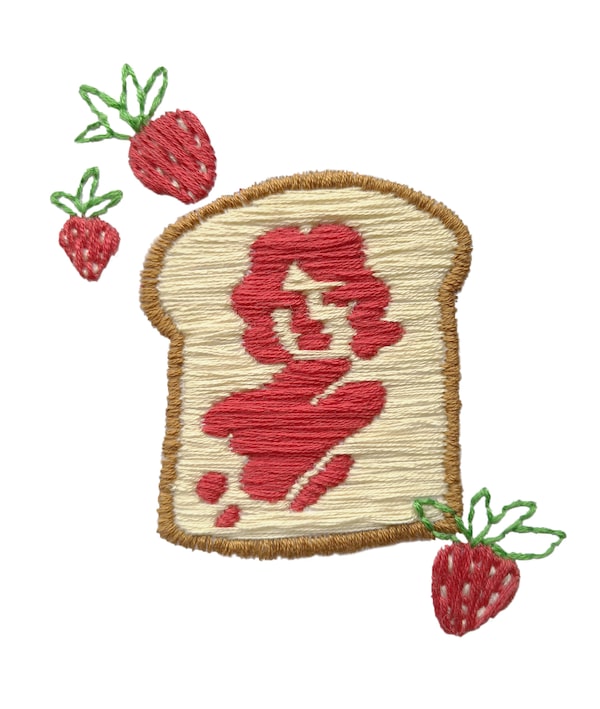
Illustration by Ashley Wong
First Person is a daily personal piece submitted by readers. Have a story to tell? See our guidelines at tgam.ca/essayguide.
I thought that I would find it quickly – the sweet noodle kugel recipe that my friend Sari made every year for Rosh Hashanah. Normally, I would have just called her and asked if she used the thin or medium noodles. But sadly, Sari died a couple of years ago, and with her went her counsel.
So, I embarked on a search through my recipe folder, a huge, overflowing mass of newspaper and magazine clippings, photocopies, recipes scrawled on tiny pieces of notepaper, yellowed hotel stationary and lipstick-stained cocktail napkins, printouts from the Internet and a few recipe cards filled out in beautiful calligraphy. There was a group of recipes I got at my wedding shower 36 years ago – all chocolate based: Rowena’s Chocolatissimo (only 10 eggs required!), Evelynne’s Chocolate Sour Cream Coffee Cake, Shirley’s Chocolate Log, Jeanette’s Chocolate-Mocha Soufflé Roll, Irene’s Ting a Lings (to my great regret, I never did manage to score her recipe for Tunnel of Fudge cake, but I live in hope) and Pat’s Chocolate Amaretto Pie.
What I thought was going to be a five-minute task, turned into two hours of perusing each recipe, remembering when I had received it, thrilled when I discovered a recipe that I thought was long-lost and deeply moved to be connected to so many women who have graced my life over the last 60 years.
Some years ago I began to realize that the transmission of traditional Jewish baking was almost lost to me. I did not have a mother who had any interest in baking, and her own mother, who was fondly known in our family as the “world’s worst cook,” was obviously not a resource. I worried that all these recipes and techniques would disappear, so I began to recruit my mother’s friends and my friends’ mothers to teach me what they knew.
My paternal grandma Sophie, at 90, spent a day teaching me how to stretch pastry for strudel, gently pulling on the paper thin dough with her gnarled hands, sitting to catch her breath after each round of stretching. My mom’s best friend, Rosalee, showed my sister and me how to make potato knishes, boiling a huge pot of potatoes, frying up a dozen onions and rolling out the dough on her special wooden knish board. My friend’s mother Shirl taught a group of us how to make rugelach, deftly modelling how to roll each cookie into a perfect crescent. I managed to score recipes for Sharon’s Passover komish broit cookies and my grandma Sophie’s mandel broit, her ambrosial cookies with a shortbread base and a meringue top (which I have still not mastered) and her potato and noodle kugels. There is also my aunt Goldie’s Passover apple cake, Janice’s blintz souflee, Marcy’s broken glass torte, her mother Adele’s hamantaschen recipe and of course, Sari’s sweet noodle kugel.
Rivka, my Israeli mother-in-law, was my real cooking teacher. I would often cook with her on Thursdays as she prepared a week’s worth of food. I learned all the basics in her kitchen. Her most impressive creations were the platters of Moroccan salads that she would create for the start of each meal; mounds of spicy glistening carrots, eggplants (both grilled and fried), tomato shakshouka, red and yellow grilled peppers and stewed okra. She taught me the importance of seasoning each layer and each ingredient so that it would stand out on its own. Her recipes for Ma’amool (a stuffed Middle Eastern cookie) and cheese borekas are the recipes of hers that I most cherish.
One of my lesser cherished recipes is one that I know by heart; my Babi Gita’s (the aforementioned world’s worst cook) strawberry jam recipe. While there was a time, many years ago, that she slogged over a hot stove to make her “famous and much loved” strawberry jam, there came a time (with advanced age and full teaching load) when she just got too tired for the whole endeavour. Since offering her jam as gifts was how she showed appreciation, she needed a replacement. As a Holocaust survivor and an escapee from Soviet post war Lithuania, Babi was the epitome of resourcefulness, courage and grit. Her mantra was, “You do what you need to do to get by.” In the case of the strawberry jam, that meant going into her garage, retrieving a purloined shopping cart from her nearby Safeway, hobbling over there on her arthritic knees and loading up the cart with jars of Kraft strawberry jam. Once home, she would invite us over to help her to carefully decant the store-bought jam into her own mason jars. I still run into people in the community who bemoan both her passing and the loss of her jam!
When I am cooking by myself in the quiet of my kitchen, I know that I am not alone; I feel the energy of these women; their senses of humour, their hard work, their advice (“knead harder, let it rest, taste and adjust”). Or my mother Ruth’s standard, “Why are you wasting your time. That’s why they have bakeries!” I am grateful to all of these women for passing on their knowledge and thereby creating such tangible links to generations of customs and stories. So much of what we all experience at the holidays is evoked by the smells and tastes of traditional foods, but for me, it is the act of creating the food that tethers me most deeply to the generations of women who preceded me. This year as I stand in my kitchen preparing for the high holy days, I stand surrounded by all of them.
Marilee Sigal lives in Vancouver.